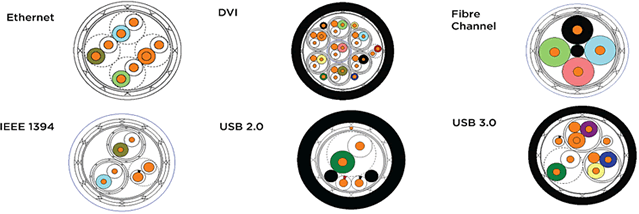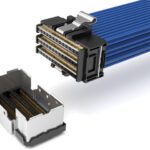Ruggedized Cables Enable Commercial Technologies in Mil/Aero Applications
Ruggedized Cables Enable Commercial Technologies in Mil/Aero Applications
Would you feel comfortable having the patch cord from your home television operating flight-critical circuits in an aircraft? Or the cable on the back of your computer responsible for the firing module on a missile? Probably not, which is why there is a need to develop and design ruggedized versions of these high-speed data cables, such as Ethernet, IEEE 1394, and USB. Figure 1 shows many cross-sections of ruggedized cables based on commercial standards.

Figure 1. Commercial cables can be ruggedized for military and aerospace use.
Ruggedization involves modifying commercial cables to meet more extreme mechanical, environmental, and thermal hazards. Because requirements differ with applications — low-fire-hazard cables on aircraft or the use of non-halogenated materials on ships — one type of ruggedization does not fit all cables.
Ruggedization most often involves replacing commercial insulations and jackets with more robust materials. A side benefit is that the new materials often allow smaller, lighter cables, an important feature in military/aerospace applications where each pound of weight savings can be worth thousands of dollars in operating costs. The smaller form factor of these ruggedized cables also enables more electronics to fit on a platform. In ruggedizing a cable, application-specific electrical specs must be maintained — 100-ohm impedance for Ethernet, for example. This means the dielectric properties of the insulation are very important. To a great degree, a cable’s characteristic impedance is a function of dielectric properties and the geometry of the conductors and dielectric. In conjunction with dielectric material selection, many polymers can be made into foams that further reduce the weight.
Beyond Mil Specs
Cable designers have freedom in meeting ruggedization requirements. Old-style military specifications — with specific recipes of materials and dimensions — are not common for new generations of cables. Rather, today’s cables must meet the electrical specs of the protocols being used and the environmental/mechanical specs of the application. Specifications are no longer driven by strict dictates for wire gauge, materials, stranding, and insulation material/thickness. While such physical attributes loosely relate to electrical and environmental performance, they also limit the possibilities and flexibility of cabling choices. Increasingly, cable specifications are driven by electrical and mechanical performance requirements.
Application requirements play an important role. A rugged cable suited to a half-meter IEEE 1394 transmission distance may not work for a 20-meter run. This is because all the high-speed protocols, with the exception of Ethernet, are designed for the application length. Therefore, the designs may vary and it is easier to go shorter distances and more difficult to achieve longer runs. When specifying a cable, it is important to identify both the application environment and the length of the cable run.
Insulation and Jacket Materials Drive Selection
The main change from commercial to rugged cable is the insulation and jacket materials, often replacing traditional PVC with more robust alternatives. The first step is typically to specify the application temperature range (see Figure 2). For example, fluoropolymers, such as FEP, have an operating temperature of 200°C, making them a good choice for high-temperature applications, of which aerospace is a prime example. Non-halogenated polyolefin-based materials rated for 125°C are ideal for shipboard applications because they do not produce toxic smoke when burned, an important attribute if you are stationed in a cold ocean, far from land. Polymer formulations for this market segment are often customized by the supplier to optimize performance in harsh conditions, including smoke and toxicity, and to exhibit fluid resistance and low flammability. Cable choices must then be evaluated for other challenges of the application.
Fluid resistance is an important characteristic. For a shipboard cable, resistance to salt spray or even the ability to block the ingress of water through a cable may be very important. For an aircraft, resistance to hydraulic fluids and jet fuel are important. In military ground vehicles, cables need to be diesel fuel-resistant. Soldier systems require cabling that will not degrade when fluids such as DEET are applied.

Figure 2. General choices start with the cable’s temperature range.
In designing ruggedized cables, suppliers also need to understand the abrasion and flexibility requirements of a cable. Does it need to withstand being run over by a tank or operate a weapons system that needs to rotate 360 degrees? While commercial cables are often good in flexing applications, when the flexing occurs at an elevated temperature the materials need to be more robust. If a low-temperature material, such as PVC, is used in a high-temperature application, like an engine, the polymer insulation may start to flow and the cable would fail in service. For soldier applications, polyurethanes are often used when ruggedized cables are sewn into clothing. Having a solution that does not restrict movement is paramount so the soldier can have the maneuverability required to aim at targets or to move quickly.
Jacket materials can be modified to highlight certain characteristics, which is especially helpful if you have a particular challenge. TE Connectivity, for example, uses special formulations to achieve specific characteristics rather than relying on generic, off-the-shelf polymers. Our expertise in material science allows us to create proprietary polymers that can be further modified to enhance performance.
Material choices involve balancing the tradeoffs in performance characteristics and, of course, cost. Because the primary function of the cable jacket is to insulate and protect, it can be made of different material than the dielectrics of the internal components. As an example, in an avionics bay, foamed dielectrics may be used in an Ethernet cable to save weight, but the jacket still needs to meet the FAA requirements for smoke, toxicity, and flammability, which necessitate the use of a more rugged solid material.
Ruggedization Saves Space and Weight
The good news with many ruggedized cables is that they are often smaller and lighter than their commercial counterparts. Crosslinking is one of the reasons for this weight savings. This is achieved through electron beam irradiation or chemical vulcanization, and the result is that the individual molecules in a polymer chain become linked together — hence, crosslinking the chains. The cross-linked materials allow thin-wall constructions by improving thermal and mechanical performance. Foaming of dielectric materials is another way to lower weight. A thin-wall cable can be around 40% smaller in diameter and 40% lighter — an important feature in aircraft and other applications where space is constrained and every ounce saved translates into greater fuel efficiency. Reducing SWaP (size, weight, and power losses) is an important concept in military and aerospace applications.
Conductors and Shielding
In addition to polymer materials, weight and size savings can also be achieved through the use of different conductors and shield types. While many commercial applications use bare copper solid conductors, tin-, silver-, or nickel-plated copper stranded conductors are common in the military/aerospace world. The plating serves to increase the temperature range and the stranding allows for increased flexibility so it can be routed through tighter spaces.
For shielding, round woven braids can be replaced with flat woven braids — a configuration where the round strands of the braid are replaced with flat strands. This allows for the same amount of shield coverage but with a reduced cable form factor and overall weight. Shields in military and aerospace applications can also be specially designed and optimized to meet specific EMI requirements, which may lessen the need for extra shields or metalized wraps.
Look Beyond Cables to Harness Systems
A ruggedized cable is only the beginning. In building cable assemblies and harnesses, make sure that heat-shrink tubing, adhesives, transitions, and molded shapes don’t become a weak link and potential source of failure. Harnessing components are available in a wide range of grades so they can be matched to application hazards and to cable performance.
Jill Choi, global product manager for specialty high performance wire and cable at TE, has expertise in polymers, customized designs, and ruggedized high-speed data cables for military and aerospace applications. She has a degree in chemical engineering as well as an MBA with a focus on leading people and organizations. To learn more, connect with Jill at [email protected].





